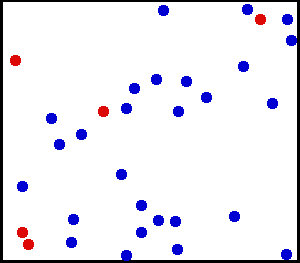链式法则是一种计算两个或多个函数的函数复合的导数的方法。
如果一个函数  依赖于一个变量
依赖于一个变量  ,而
,而  又依赖于另一个变量
又依赖于另一个变量  ,也就是说
,也就是说  ,那么
,那么  相对于
相对于  的变化率可以计算为
的变化率可以计算为  相对于
相对于  的变化率乘以
的变化率乘以  相对于
相对于  的变化率。
的变化率。
该方法被称为“链式法则”,因为它可以依次应用于嵌套在彼此内部的任意多个函数。[1] 例如,如果  是
是  的函数,而
的函数,而  又是一个
又是一个  的函数,而
的函数,而  又是一个
又是一个  的函数,即
的函数,即

关于  的
的  的导数由下式给出:
的导数由下式给出:
 等等。
等等。
一个有用的记忆方法是将微分视为可以代数抵消的个体实体,例如

但是,请记住,这种技巧是通过巧妙的符号选择实现的,而不是通过实际的代数抵消。
链式法则在物理学、化学和工程学中有着广泛的应用,同时也被用于研究许多学科中的相关变化率。链式法则也可以推广到多个变量的情况,其中嵌套函数依赖于多个变量。
假设一位登山者以  的速度攀登。气温随海拔升高而降低;假设其降低率为
的速度攀登。气温随海拔升高而降低;假设其降低率为  每公里。要计算登山者每小时感受到的气温下降量,将
每公里。要计算登山者每小时感受到的气温下降量,将  乘以
乘以  ,得到
,得到  。此计算是一个典型的链式法则应用。
。此计算是一个典型的链式法则应用。
考虑函数  。根据链式法则,我们可以得到
。根据链式法则,我们可以得到
 |
需要求导的函数 |
 |
定义  为内部函数 为内部函数 |
 |
用  表示 表示  |
 |
表示此处适用的链式法则 |
 |
代入  和 和  |
 |
使用幂法则计算导数 |
 |
将  用 用  表示代回 表示代回 |
 |
化简。 |
为了对三角函数

进行求导,我们可以写成
 |
需要求导的函数 |
 |
定义  为内部函数 为内部函数 |
 |
用  表示 表示  |
 |
表示此处适用的链式法则 |
 |
代入  和 和  |
 |
计算导数 |
 |
将  用 用  表示。 表示。 |
链式法则可以用来求导  ,即绝对值函数
,即绝对值函数
 |
需要求导的函数 |
 |
等效函数 |
 |
定义  为内部函数 为内部函数 |
 |
用  表示 表示  |
 |
表示此处适用的链式法则 |
 |
代入  和 和  |
 |
使用幂法则计算导数 |
 |
将  用 用  表示代回 表示代回 |
 |
化简 |
 |
将  表达为绝对值。 表达为绝对值。 |
该方法被称为“链式法则”,因为它可以依次应用于嵌套在彼此之内的任意多个函数。例如,如果  ,链式法则的依次应用会产生以下导数(我们利用了
,链式法则的依次应用会产生以下导数(我们利用了  的事实,这将在后面的部分中证明)。
的事实,这将在后面的部分中证明)。
 |
原始(最外层)函数 |
 |
将  定义为最内层函数 定义为最内层函数 |
 |
 作为中间函数 作为中间函数 |
 |
表示此处适用的链式法则 |
 |
对 f(g) 求导[2] |
 |
对  求导 求导 |
 |
对  求导 求导 |
 |
代入链式法则。 |
由于一个物理量通常依赖于另一个物理量,而另一个物理量又依赖于其他物理量,因此链式法则在物理学中有着广泛的应用。本节将介绍链式法则在运动学和简谐运动中的应用实例。链式法则在电磁感应中也很有用。
 一辆车正向北行驶,目前位于
一辆车正向北行驶,目前位于  ; 另一辆车正向西行驶,目前位于
; 另一辆车正向西行驶,目前位于  。可以使用链式法则来判断它们是越来越近还是越来越远。
。可以使用链式法则来判断它们是越来越近还是越来越远。
例如,可以考虑一个运动学问题,一辆车以 80 英里/小时的速度向西行驶至十字路口,而另一辆车以 60 英里/小时的速度向北行驶远离十字路口。可以问这两辆车是越来越近还是越来越远,以及当北行车距离十字路口 3 英里,而西行车距离十字路口 4 英里时,它们之间的距离变化率是多少。
核心思想:使用链式法则计算两辆车之间距离的变化率。
- 计划
- 选择坐标系
- 识别变量
- 绘制图形
- 核心思想:使用链式法则计算两辆车之间距离的变化率
- 使用勾股定理将
 表示为
表示为  和
和  的表达式。
的表达式。
- 使用链式法则将
 表示为
表示为  和
和  的表达式。
的表达式。
- 代入

- 化简。
选择坐标系:令  -轴指向北方,
-轴指向北方, -轴指向东方。
-轴指向东方。
识别变量:定义  为向北行驶的车辆与原点的距离,并定义
为向北行驶的车辆与原点的距离,并定义  为向西行驶的车辆与原点的距离。
为向西行驶的车辆与原点的距离。
使用勾股定理将  表示为
表示为  和
和  的表达式。
的表达式。

使用链式法则将  表示为
表示为  和
和 
 |
对整个函数应用导数运算符 |
 |
函数内部是平方和 |
![{\displaystyle ={\frac {(x^{2}+y^{2})^{-{\frac {1}{2}}}}{2}}\left[{\frac {d}{dt}}(x^{2})+{\frac {d}{dt}}(y^{2})\right]}](https://wikimedia.org/api/rest_v1/media/math/render/svg/a9b656c37ba8c39165514d9c4f0aa65607823dec) |
分配微分运算符 |
![{\displaystyle ={\frac {(x^{2}+y^{2})^{-{\frac {1}{2}}}}{2}}\left[2x\cdot {\frac {dx}{dt}}+2y\cdot {\frac {dy}{dt}}\right]}](https://wikimedia.org/api/rest_v1/media/math/render/svg/bcb61fdaf2803d1535e1cc73516ecb68202d807b) |
对  和 和  应用链式法则 应用链式法则 |
 |
化简。 |
代入  并简化
并简化

|

|
|
|

|
|
|

|
|
|

|
因此,两辆车以 的速度互相靠近。
的速度互相靠近。
 无阻尼的弹簧-质量系统是一个简单的谐振子。
无阻尼的弹簧-质量系统是一个简单的谐振子。
如果一个简单谐振子偏离平衡位置的位移为 ,并且在时间
,并且在时间 时从其最大位移
时从其最大位移 释放,则之后的时间位置由下式给出:
释放,则之后的时间位置由下式给出:

其中 是角频率,
是角频率, 是振荡周期。速度
是振荡周期。速度 ,作为位置的一阶时间导数,可以用链式法则计算
,作为位置的一阶时间导数,可以用链式法则计算
 |
一维速度定义 |
 |
代入 |
 |
将常数 提取到导数之外 提取到导数之外 |
 |
对外部函数(余弦)求导 |
 |
将负号移到前面 |
 |
计算剩下的导数 |
 |
化简。 |
加速度是位置的二阶导数,或者简称为  .
.
 |
一维加速度的定义 |
 |
代入  |
 |
将常数项移到导数的外面 |
 |
对外部函数(正弦)求导 |
 |
计算剩下的导数 |
 |
化简。 |
根据牛顿第二定律,  ,其中
,其中  是合力,
是合力,  是物体的质量。
是物体的质量。

|
牛顿第二定律 |
 |
将  代入 代入 |
 |
化简 |
 |
将原始  代入。 代入。 |
因此可以看出,这些结果与对简单谐振子施加的力是位移负常数倍的观测结果一致。
链式法则在化学中有许多应用,因为化学中的许多方程描述了某个物理量如何依赖于另一个量,而另一个量又依赖于另一个量。例如,理想气体定律描述了压力、体积、温度和摩尔数之间的关系,所有这些量也可能随时间变化。
 理想气体的等温线。曲线表示理想气体在不同温度下压力和体积之间的关系:离原点越远的曲线(即靠近图表右上角的曲线)代表更高的温度。
理想气体的等温线。曲线表示理想气体在不同温度下压力和体积之间的关系:离原点越远的曲线(即靠近图表右上角的曲线)代表更高的温度。
假设一个  摩尔的理想气体被保存在一个等温(恒温,
摩尔的理想气体被保存在一个等温(恒温, )容器中,初始体积为
)容器中,初始体积为  。理想气体被活塞压缩,使其体积以恒定速率变化,使得
。理想气体被活塞压缩,使其体积以恒定速率变化,使得  ,其中
,其中  是时间。链式法则可以用来求压力的变化率。[3] 理想气体定律可以求解压力,
是时间。链式法则可以用来求压力的变化率。[3] 理想气体定律可以求解压力,  ,得到
,得到

其中  和
和  已被写成时间的显式函数,其他符号为常数。对两边求导得到
已被写成时间的显式函数,其他符号为常数。对两边求导得到

其中常数项  已经移到了导数运算符的左侧。应用链式法则得到
已经移到了导数运算符的左侧。应用链式法则得到

其中,已使用幂法则对  进行求导。由于
进行求导。由于  ,
, 。将
。将  和
和  代入,得到
代入,得到  。
。

 理想单原子气体的温度是其原子平均动能的量度。在 1950 个大气压下,氦原子的大小相对于其间距按比例显示。原子具有特定的平均速度,这里比室温降低了 2 万亿倍。
理想单原子气体的温度是其原子平均动能的量度。在 1950 个大气压下,氦原子的大小相对于其间距按比例显示。原子具有特定的平均速度,这里比室温降低了 2 万亿倍。
链式法则在化学中的另一个应用是求理想气体中平均分子速度  随绝对温度
随绝对温度  以恒定速率增加时的变化率,使得
以恒定速率增加时的变化率,使得  ,其中
,其中  是初始温度,而
是初始温度,而  是时间。[3] 气体动理论将分子速度的 均方根 与温度相关联,因此如果
是时间。[3] 气体动理论将分子速度的 均方根 与温度相关联,因此如果  和
和  是时间的函数,
是时间的函数,

其中  是理想气体常数,而
是理想气体常数,而  是分子量。
是分子量。
对等式两边关于时间求导得到

使用链式法则,以关于温度  和时间
和时间  分别表示右侧,得到
分别表示右侧,得到

计算关于温度  的导数得到
的导数得到

对剩余的关于 的导数进行求解,取负次幂的倒数,并将
的导数进行求解,取负次幂的倒数,并将 代入,得到
代入,得到

对关于 的导数进行求解,得到
的导数进行求解,得到

简化为

假设  是
是  的函数,而
的函数,而  又 是
又 是  的函数(假设
的函数(假设  在
在  和
和  处可微分,而
处可微分,而  在
在  处可微分)。为了证明链式法则,我们使用导数的定义。
处可微分)。为了证明链式法则,我们使用导数的定义。

现在,我们将  乘以
乘以  ,并进行一些代数运算。
,并进行一些代数运算。

请注意,当  趋近于
趋近于  时,
时, 也趋近于
也趋近于  。因此,当
。因此,当  趋近于
趋近于  时,对一个函数求极限与当
时,对一个函数求极限与当  趋近于
趋近于  时,对这个函数求极限是一样的。因此
时,对这个函数求极限是一样的。因此

所以我们有

1. 求

的值,如果

,首先通过展开和直接求导,然后通过对

应用链式法则,其中

。比较答案。


2. 使用链式法则求导数

, 令

和

。


解答









































































![{\displaystyle ={\frac {(x^{2}+y^{2})^{-{\frac {1}{2}}}}{2}}\left[{\frac {d}{dt}}(x^{2})+{\frac {d}{dt}}(y^{2})\right]}](https://wikimedia.org/api/rest_v1/media/math/render/svg/a9b656c37ba8c39165514d9c4f0aa65607823dec)
![{\displaystyle ={\frac {(x^{2}+y^{2})^{-{\frac {1}{2}}}}{2}}\left[2x\cdot {\frac {dx}{dt}}+2y\cdot {\frac {dy}{dt}}\right]}](https://wikimedia.org/api/rest_v1/media/math/render/svg/bcb61fdaf2803d1535e1cc73516ecb68202d807b)


















































































